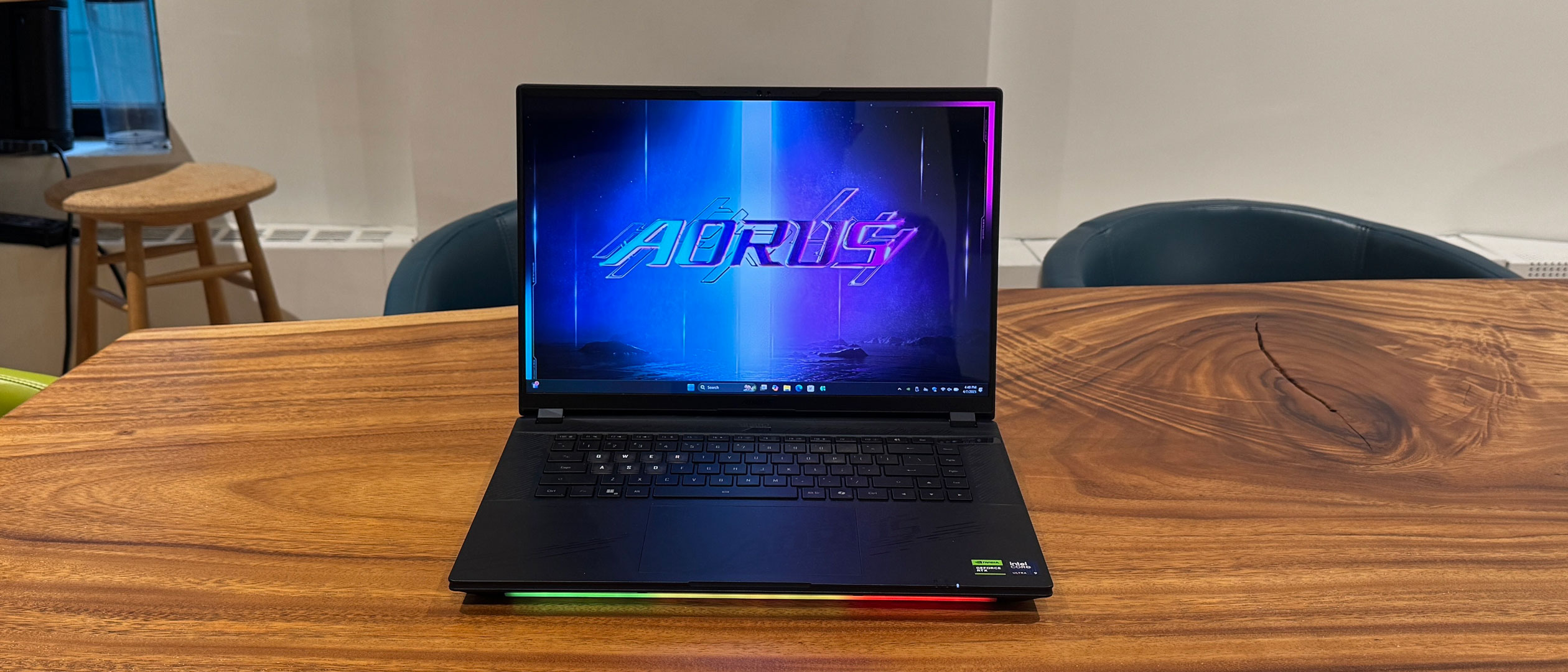Tom's Hardware Verdict
The Gigabyte Aorus Master 16 is a strong gaming laptop with an Nvidia RTX 5080 Laptop GPU and a bright display, but it doesn't feel as premium as its price tag, and its GiMate AI doesn't add much.
Pros
- +
Solid gaming performance
- +
Bright display
- +
Second M.2 SSD slot
Cons
- -
Design is overly plasticky
- -
Pricey
- -
GiMate AI is a gimmick
- -
Red Dead Redemption 2 crashed at 1080p
Why you can trust Tom's Hardware
There are so many PCs that are Pro, Plus, Max, or some similar combination, that when I hear "Master," it better be cream of the crop — one of the best gaming laptops. The Gigabyte Aorus Master 16, with its RTX 5080 laptop GPU and Intel Core Ultra 9 275 HX is a strong performer with a bright OLED screen, but there’s still room for improvement.
The Aorus Master starts at $3,099.99, which isn't cheap. For that, I expect top-tier build quality. And Gigabyte's other big push on the Aorus Master is its GiMate AI, which I found to be of dubious utility.
That doesn't make the Aorus Master a bad gaming laptop – the performance is certainly there. But you'll have to decide if you're willing to accept some flaws and limitations while spending over three grand.
Design of the Gigabyte Aorus Master 16
The Gigabyte Aorus Master 16 is an expensive laptop, but it doesn't feel like it. Though many gaming laptops use plastic to prevent overheating and reduce weight, Gigabyte's implementation of the material doesn't feel great. The system feels cheap in spots.
For instance, the lid has a lenticular material that reveals a ribbed pattern around the RGB-lit Aorus falcon logo. But the material feels like something I’d expect from a Happy Meal toy. At least on the lid, Gigabyte should've gone with premium aluminum. This laptop is over $3,000.
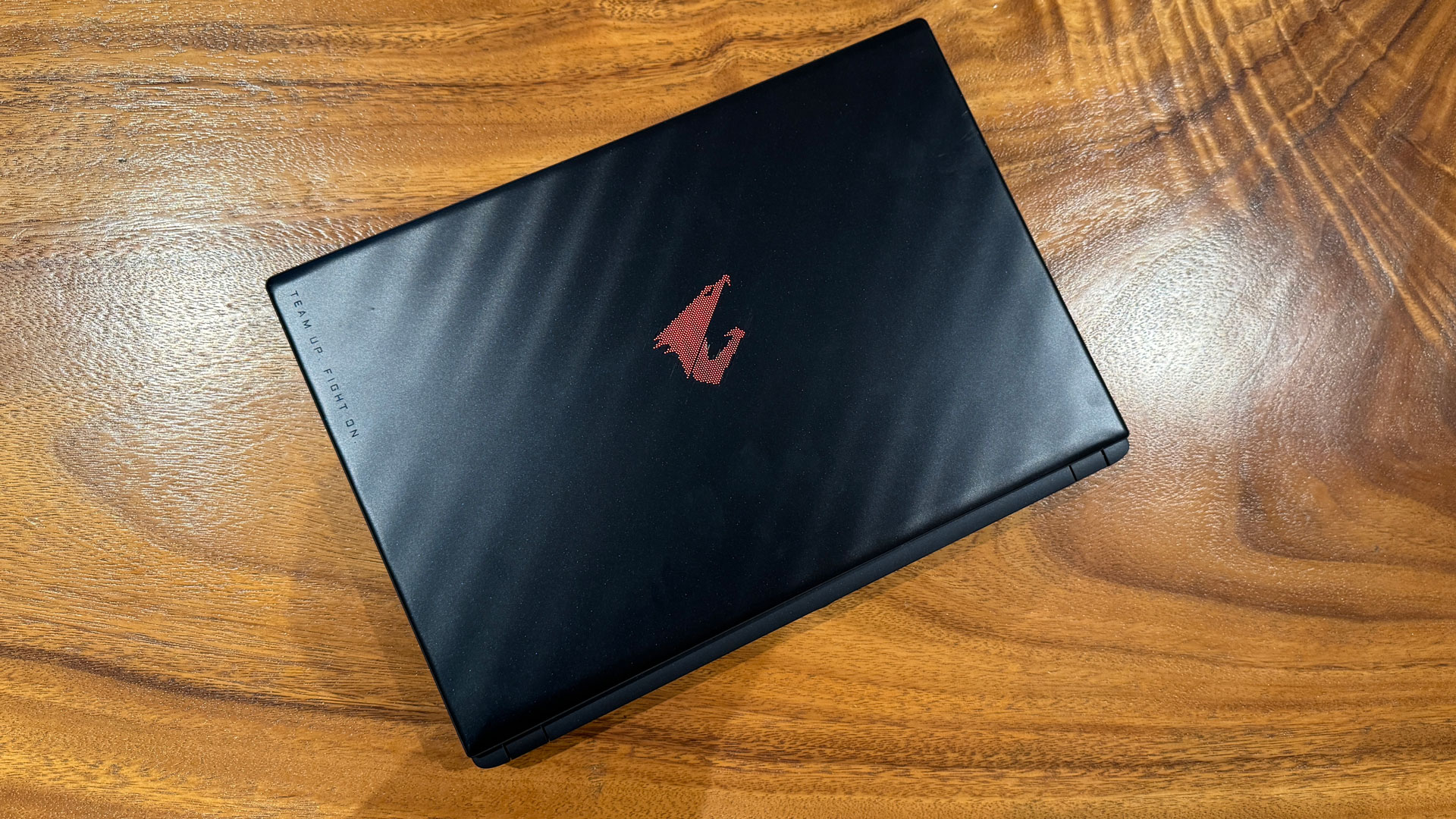
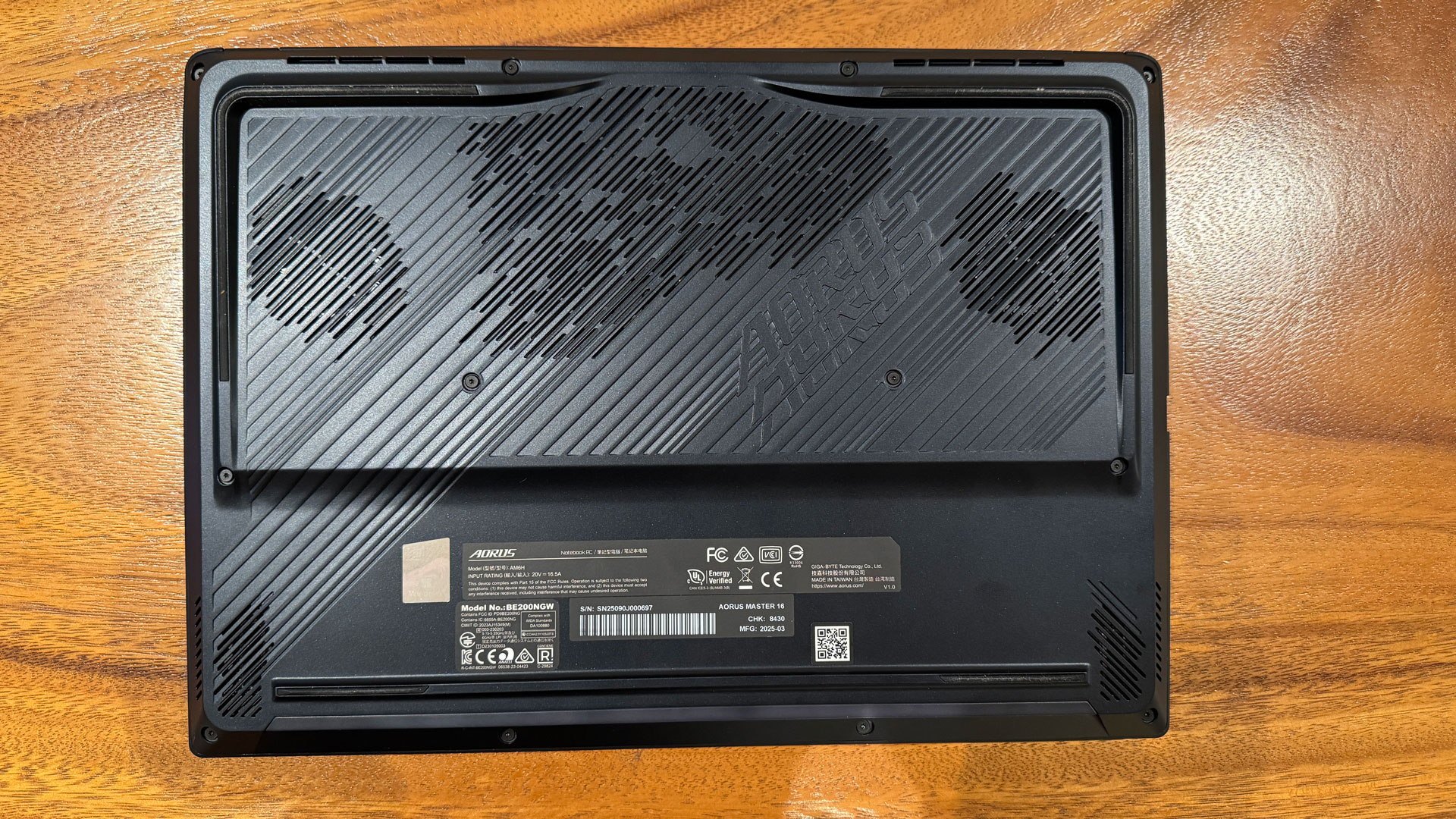
When you open the laptop, the Aorus branding is prominent. Besides a space on the bottom bezel, the Aorus logo is also displayed garishly across the touchpad, spilling onto the palm rest. Mix that with the RGB keyboard (including a handful of transparent keys), and there's no mistake that this laptop is meant not just for gaming, but for gamers. We’ve seen similar styling from Asus, particularly under its Strix Scar brand, but there’s definitely an abundance of gamer signaling going on here.
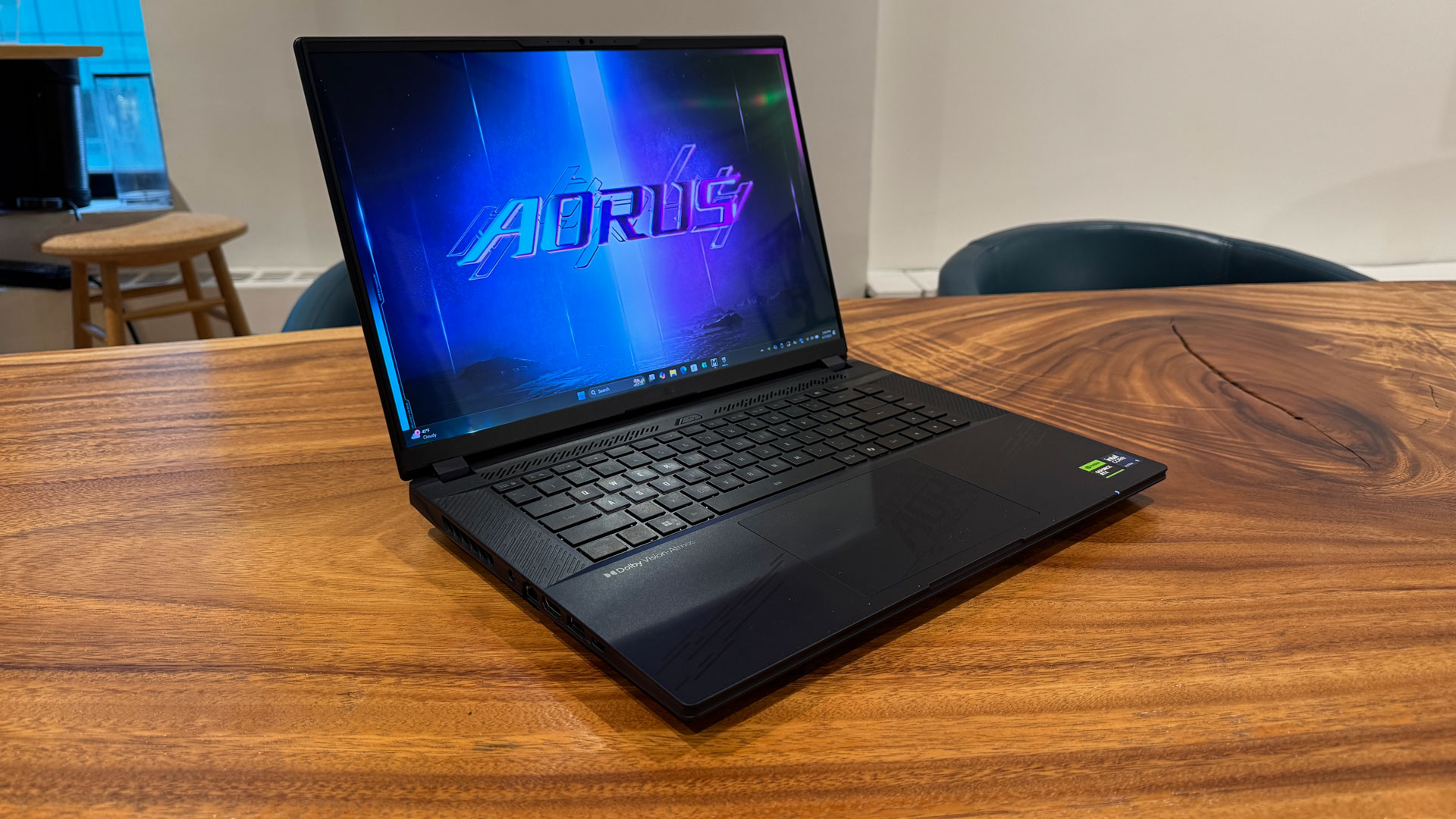
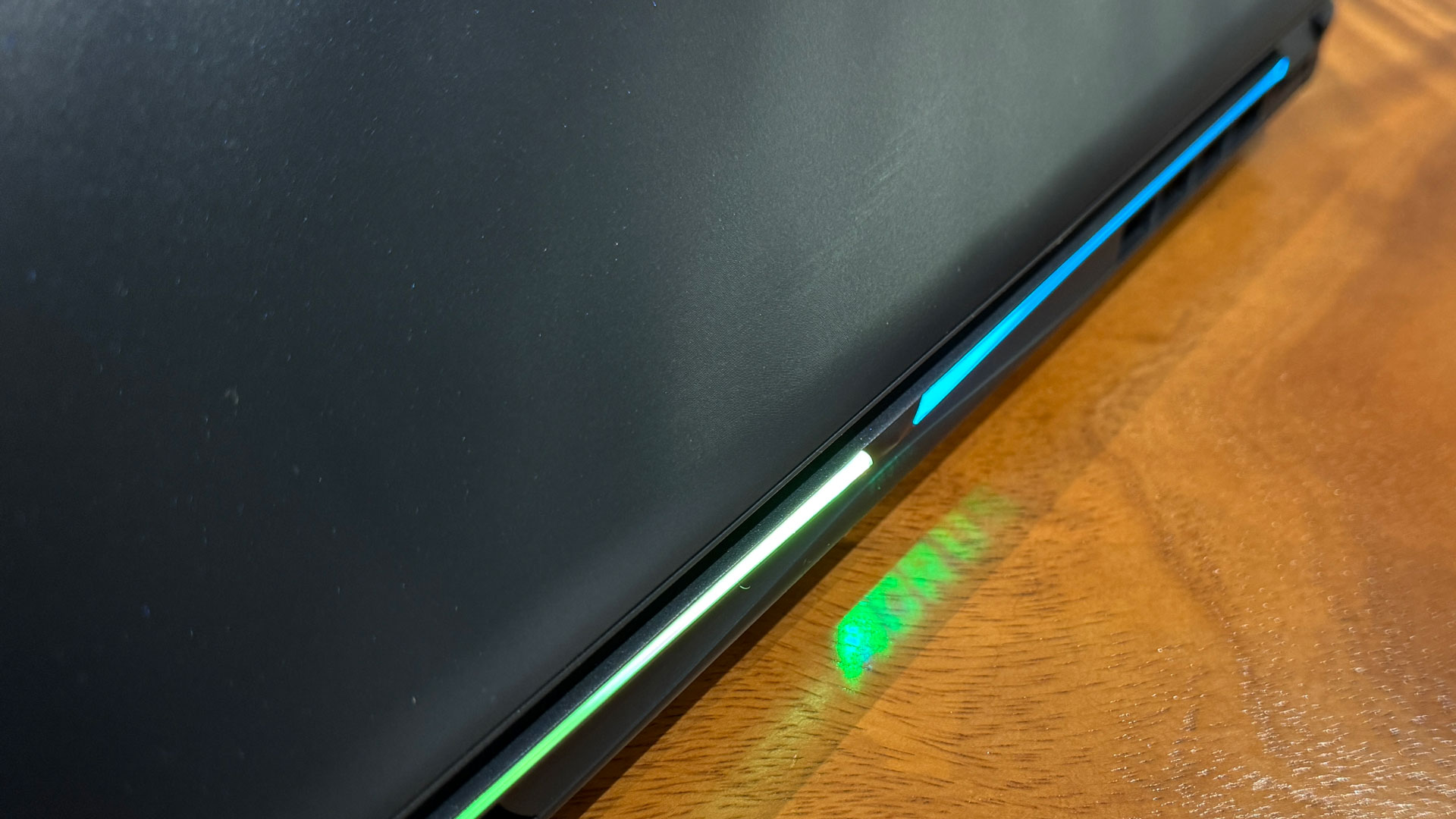
There's plenty of RGB, including a light bar underneath the palm rest and a second on the rear of the laptop. There is also a small RGB projection of the Aorus wordmark from the rear of the laptop. My editor told me it "looks like the RGB is leaking."
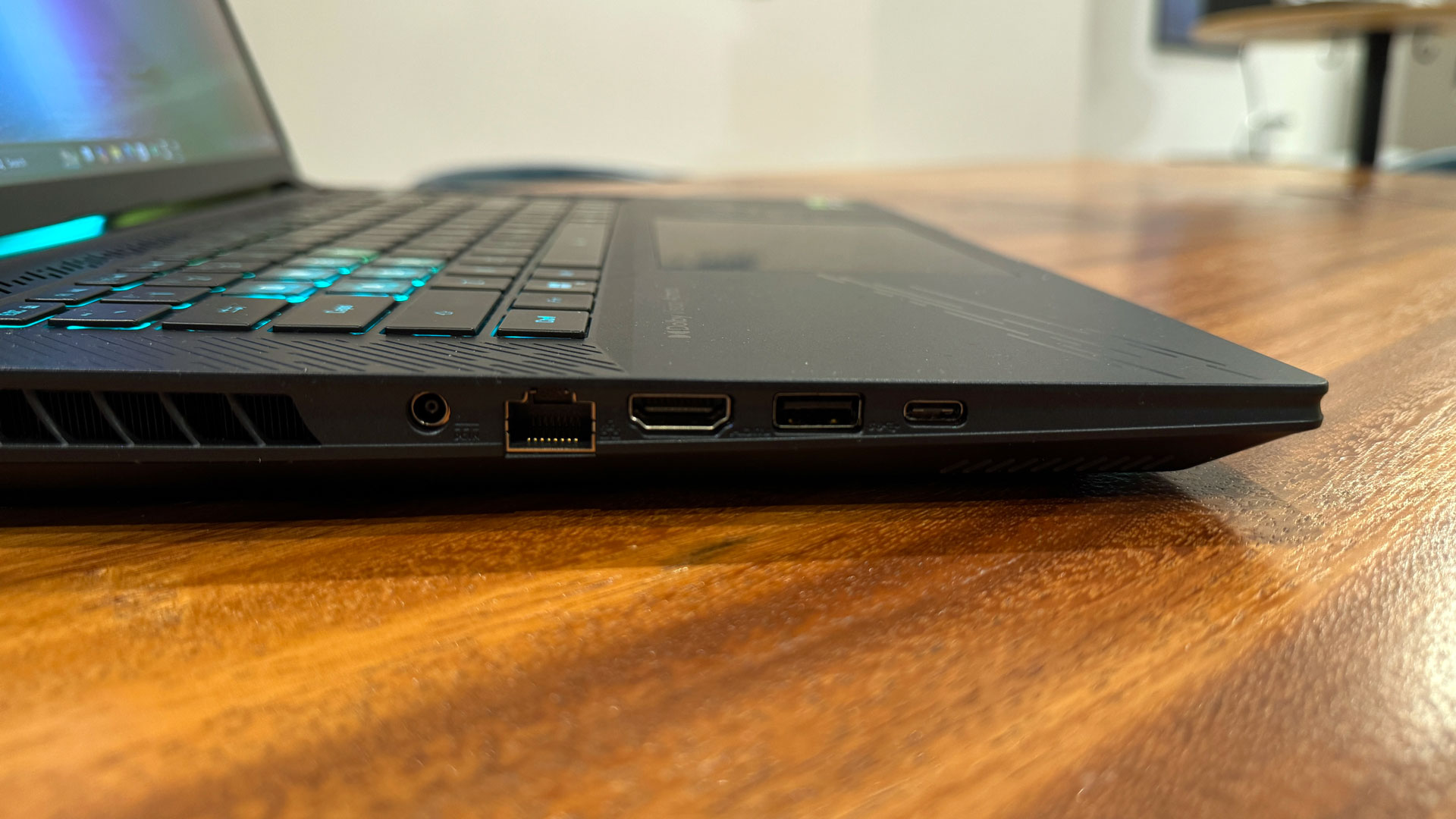
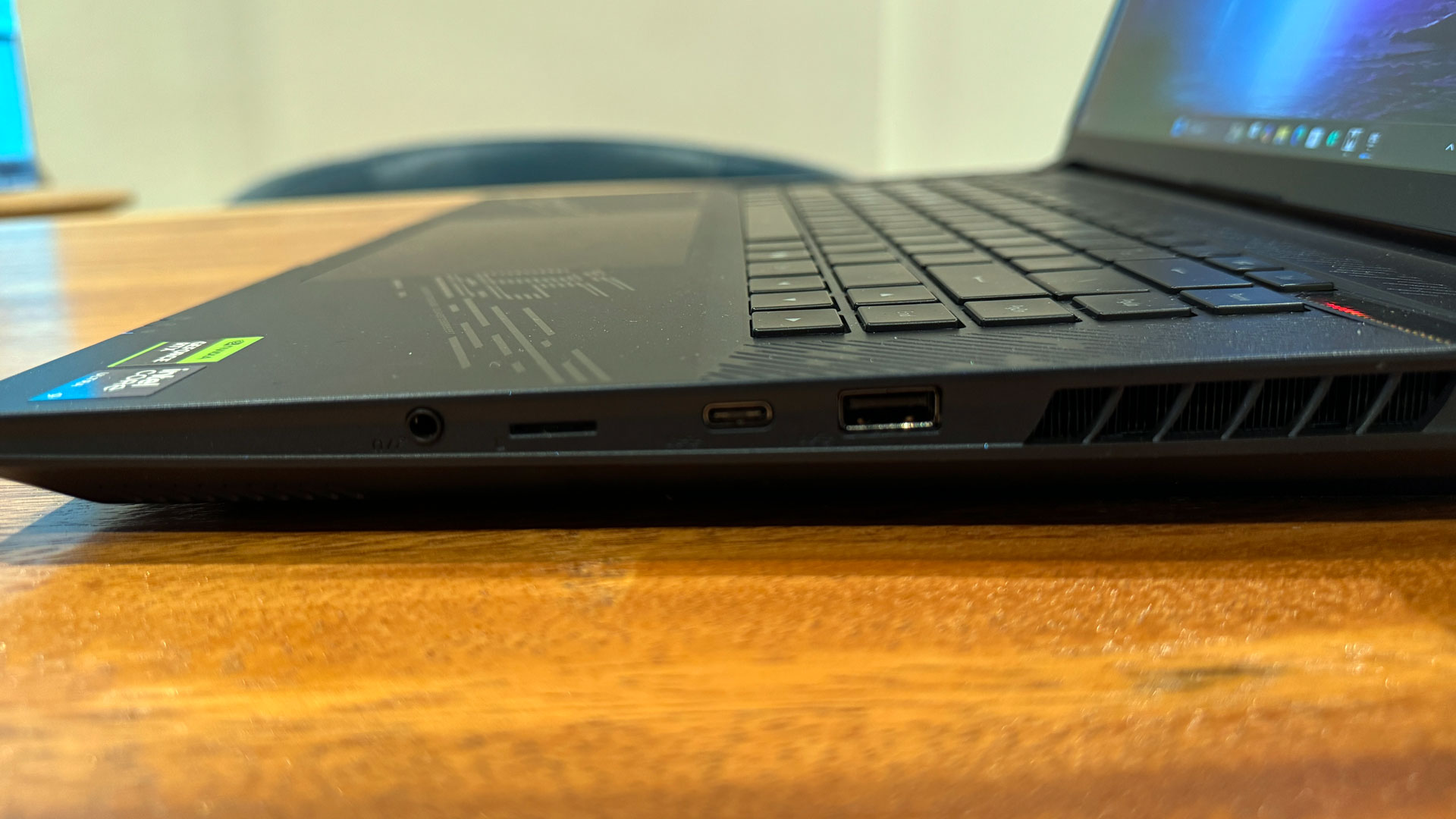
On the left side of the laptop, there's a Thunderbolt 5 port over USB Type-C, a USB 3.2 Gen 2 Type-A port, HDMI 2.1, and an Ethernet jack. On the right side, there's another USB-A port, a Thunderbolt 4 port over USB-C, a microSD card slot, and a headphone jack. I'd rather see a full-size SD card slot on a laptop of this size (there seems to be room for it)

While I understand the desire to avoid putting ports on the rear of the laptop to allow for cooling, I wish the ports on the sides were closer to the back of the system. The power cable, in particular, was kind of bothersome when it was jutting out the side so close to the front.
Measuring 14.06 x 10.0 x 1.18 inches and weighing in at 5.51 pounds, the Aorus Master 16 isn't the most portable of gaming laptops. The Razer Blade 16 is trimmer at 13.98 x 9.86 x 0.69 inches and 4.72 pounds. The Alienware m18 R2 with an RTX 4090 and an 18-inch display was 16.15 x 12.59 x 1.05 inches and 8.63 pounds, while the HP Omen 16 was wider but thinner at 14.53 x 10.21 x 0.93 inches and weighed a similar 5.4 pounds.
Get Tom's Hardware's best news and in-depth reviews, straight to your inbox.
Gigabyte Aorus Master 16 Specifications
CPU | Intel Core Ultra 9 275HX |
Graphics | Nvidia GeForce RTX 5080 Laptop GPU (16GB GDDR7, 175W maximum TGP, 1,702 MHz boost clock) |
Memory | 32GB DDR5-5600 |
Storage | 2TB PCIe Gen 4 M.2 SSD |
Display | 16-inch, 2560 x 1600, 240 Hz, OLED |
Networking | Intel Wi-Fi 7 BE200, Bluetooth 5.4 |
Ports | USB Type-C with Thunderbolt 5, USB-C with Thunderbolt 4, 2x USB 3.2 Gen 2 Type-A, MicroSD card slot (UHS-II), HDMI 2.1, Ethernet, 3.5mm headphone jack |
Camera | 1080p IR webcam |
Battery | 99 WHr |
Power Adapter | 330W |
Operating System | Windows 11 Home |
Dimensions (WxDxH) | 14.06 x 10.0 x 1.18 inches (357.12 x 254 x 29.97 mm) |
Weight | 5.51 pounds / 2.5 kg |
Price (as configured) | $3,099.99 |
Gaming and Graphics on the Gigabyte Aorus Master 16
For gaming, the Gigabyte armed the Aorus Master 16 with an Nvidia GeForce RTX 5080 Laptop GPU and an Intel Core Ultra 9 275HX. These allow for solid gaming performance. And, as you'll see below, the 55 W CPU allows for stronger 1080p performance than the 28W part in the Razer Blade 16, despite that laptop having a 5090.
I used the Aorus Master 16 to continue my adventures in Alan Wake 2. I used the Quality render setting at native resolution with DLSS and 4x Frame Gen enabled, along with the high-quality graphics preset and ultra ray tracing. As I explored some previously haunted woods (look, things can get less haunted in this game), the frame rate ranged between 90 and 133 frames per second. Frame Gen was a necessity for these settings, though. Without them, the game sometimes ran below 30 frames per second, so I would have to turn the quality down.
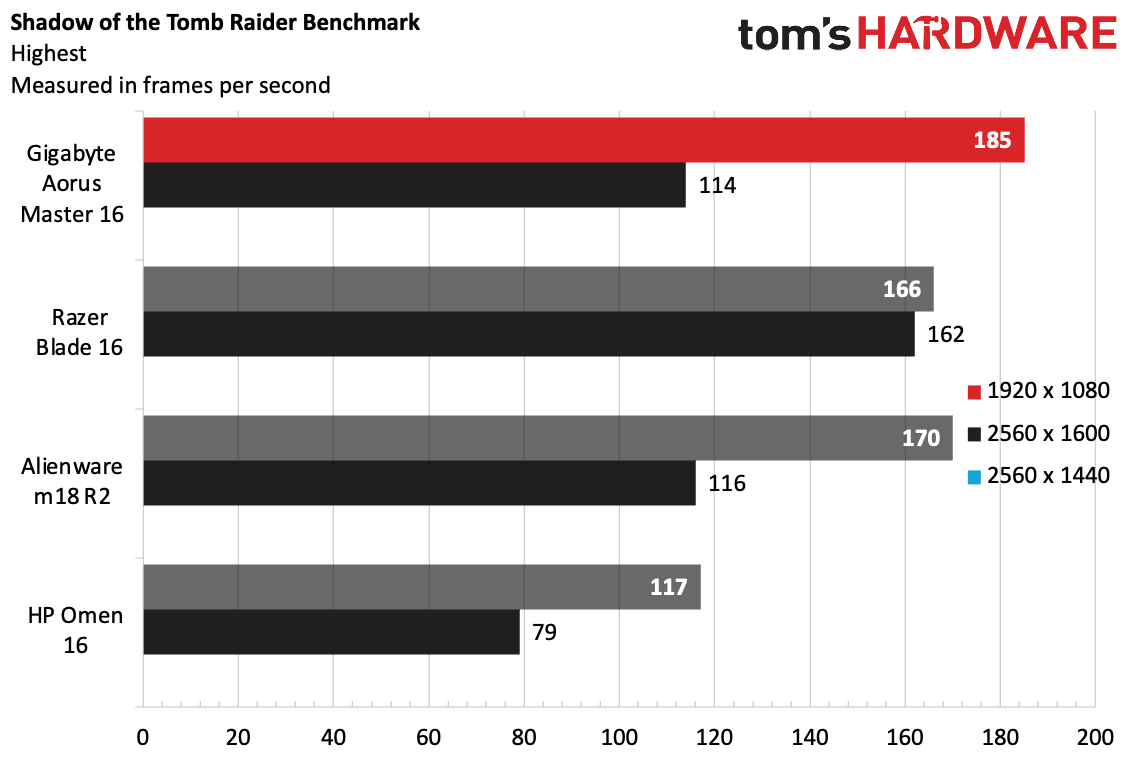
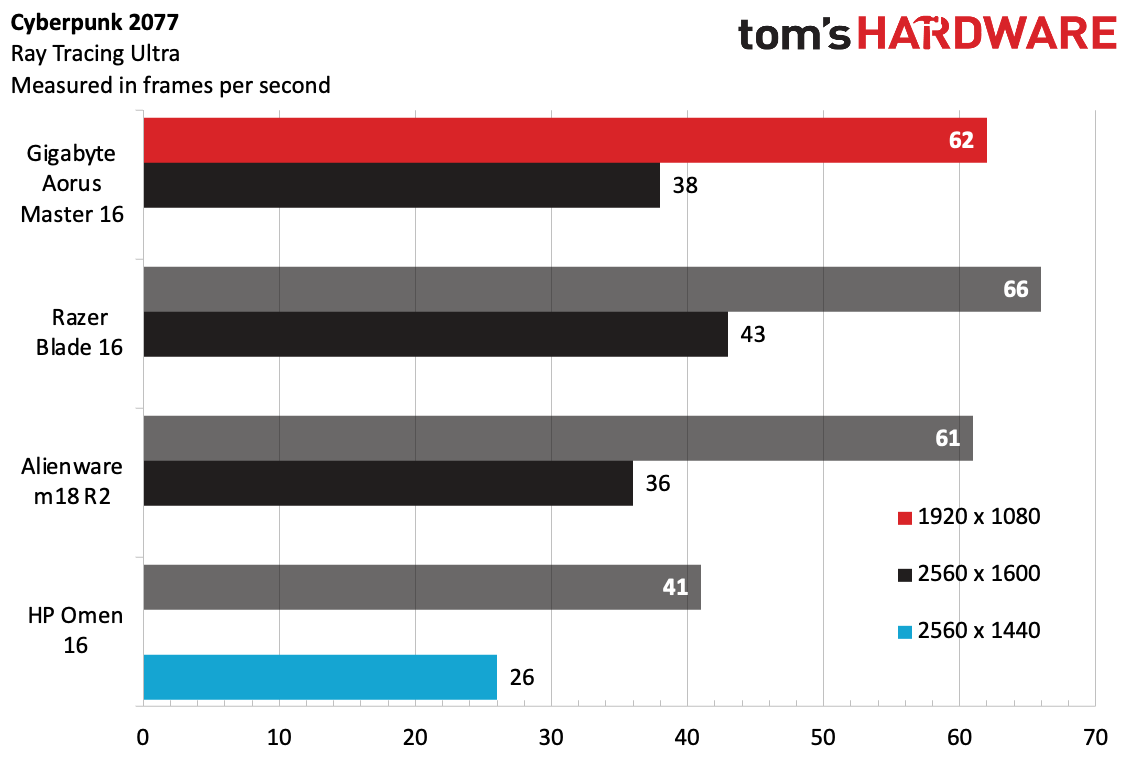
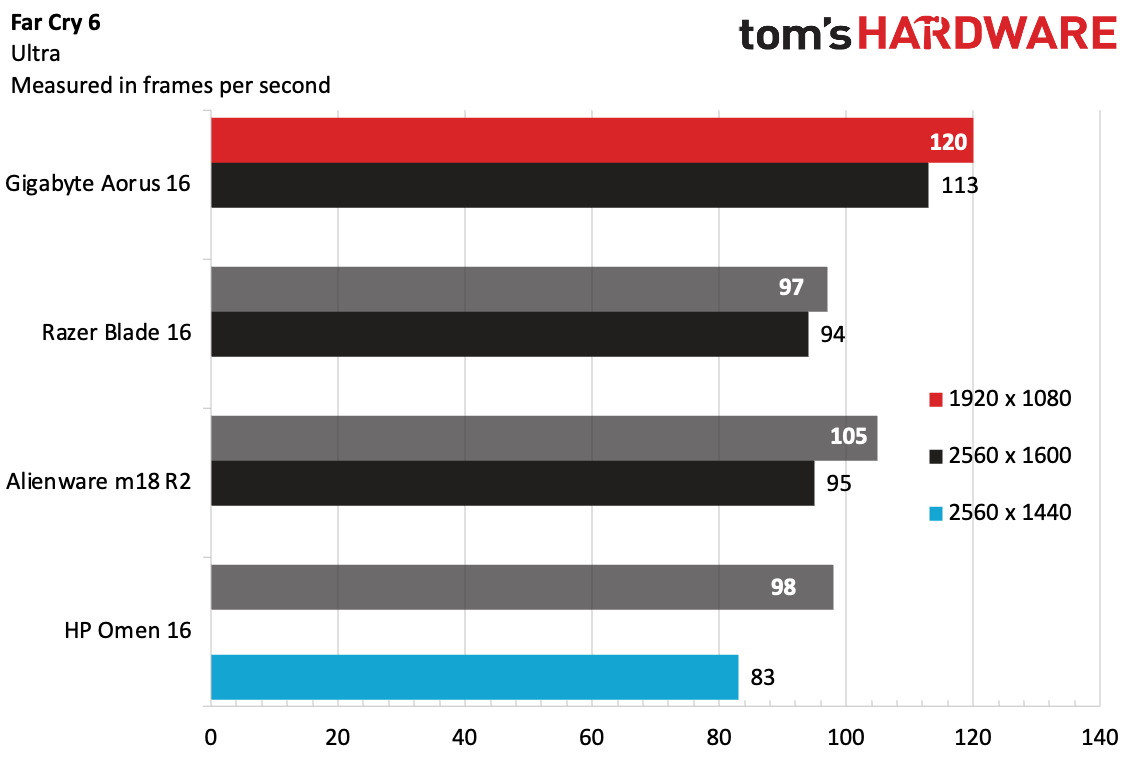
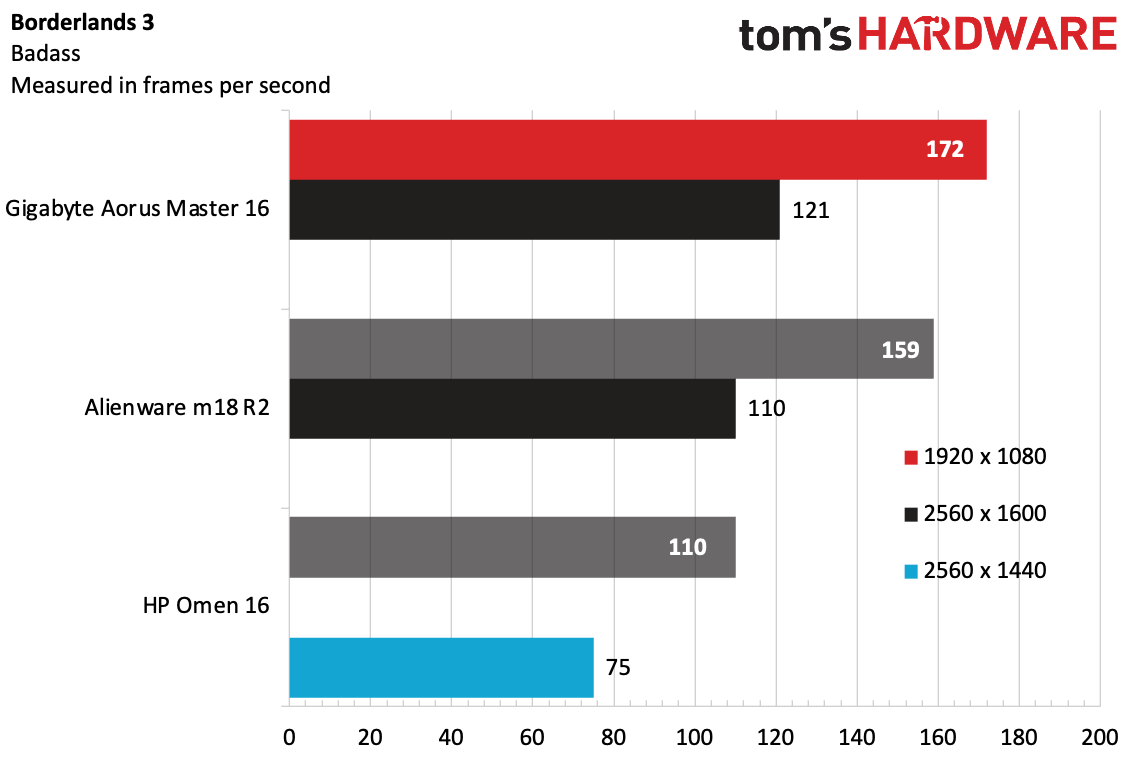
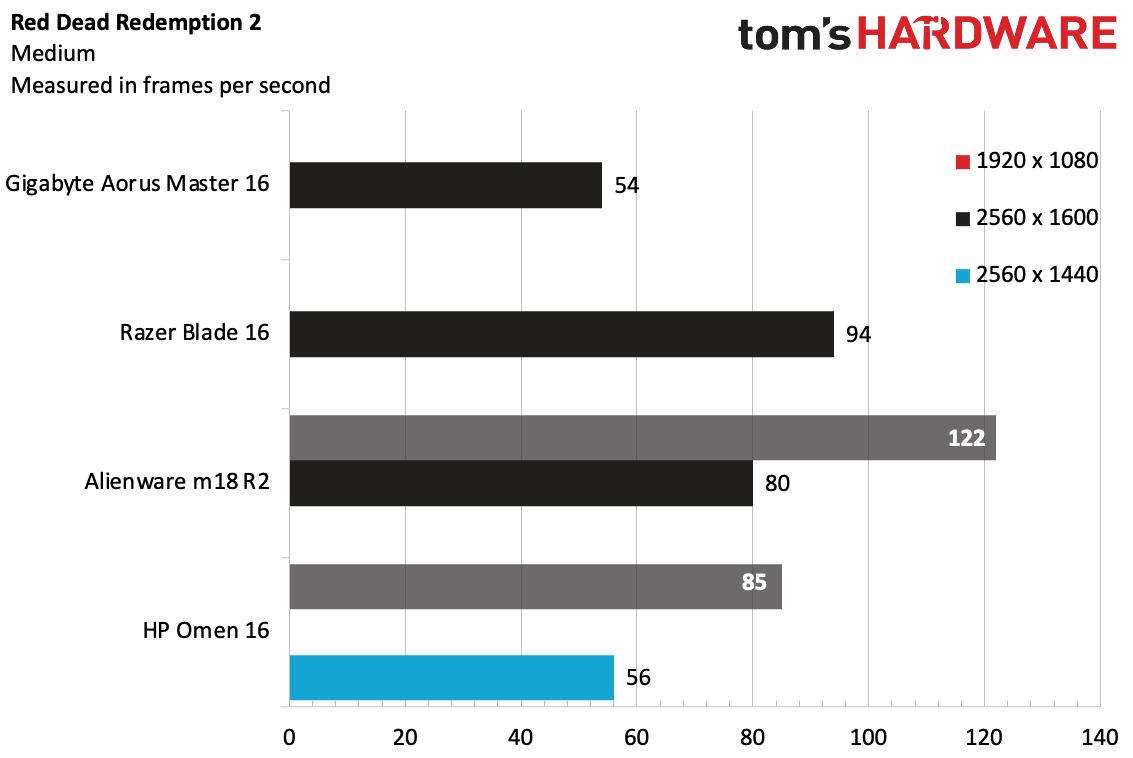
Across our benchmarks, the Aorus Master 16 was the top performer at 1080p, hitting 185 frames per second on Shadow of the Tomb Raider, 172 FPS on Borderlands 3, and 120 FPS on the CPU-centric Far Cry 6.
At high resolutions, though, the Blade 16's RTX 5090 won out, as games are typically less dependent on the CPU as you add more pixels. So on Cyberpunk 2077 at ultra settings, the Blade 16 hit 43 FPS, while the Master was a tad behind at 38 FPS, while on Shadow of the Tomb Raider's highest settings, the Master hit 114 FPS while the Blade 16 reached 162 FPS. (In fact, the Master didn't beat the previous gen 4090 here). The exception was Far Cry 6, where the Aorus hit 113 FPS at 2560 x 1600.
We did have some snags. Like the 5090 on the Razer Blade 16, the Master's 5080 couldn't run Red Dead Redemption 2 at 1080p — Nvidia clearly has some driver issues to work through — though it ran Borderlands 3 where its 50-series peer couldn't.
We stress-tested the system with Metro Exodus at the RTX preset, using 15 runs to simulate half an hour of gaming. The system ran the gaming benchmark at an average of 111.45 FPS and was largely consistent run-to-run.
The CPU's performance cores ran at an average of 4.8 GHz during the test, while the efficiency cores averaged at 1.68 GHz. The CPU package measured 81.21 Celsius. Meanwhile, the GPU ran at 1,609.59 MHz and climbed to 60.50 degrees C.
Productivity Performance on the Gigabyte Aorus Master 16
The Gigabyte Aorus Master 16 utilizes an Intel Core Ultra 9 275HX processor, a 24-core (8 performance cores, 16 efficiency cores), 55 W processor. Outside of gaming, it should meet on-the-go productivity needs. In our review unit, it was paired with 32GB of RAM and a 2TB SSD.
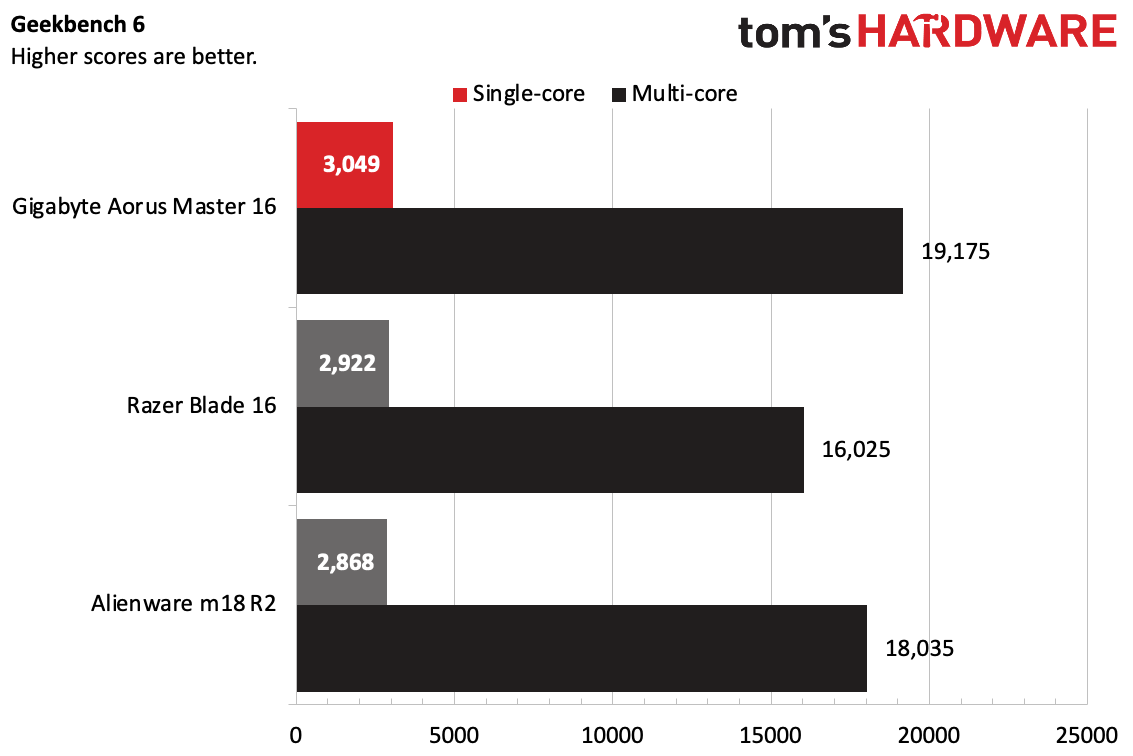
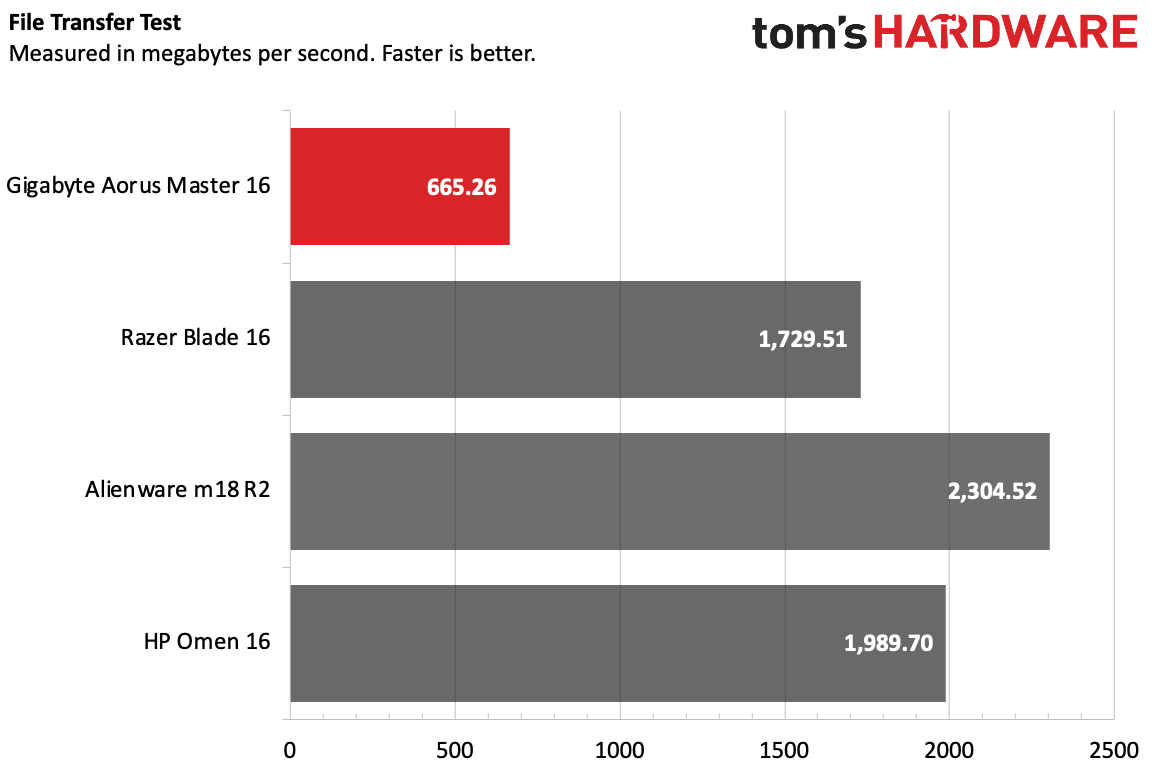
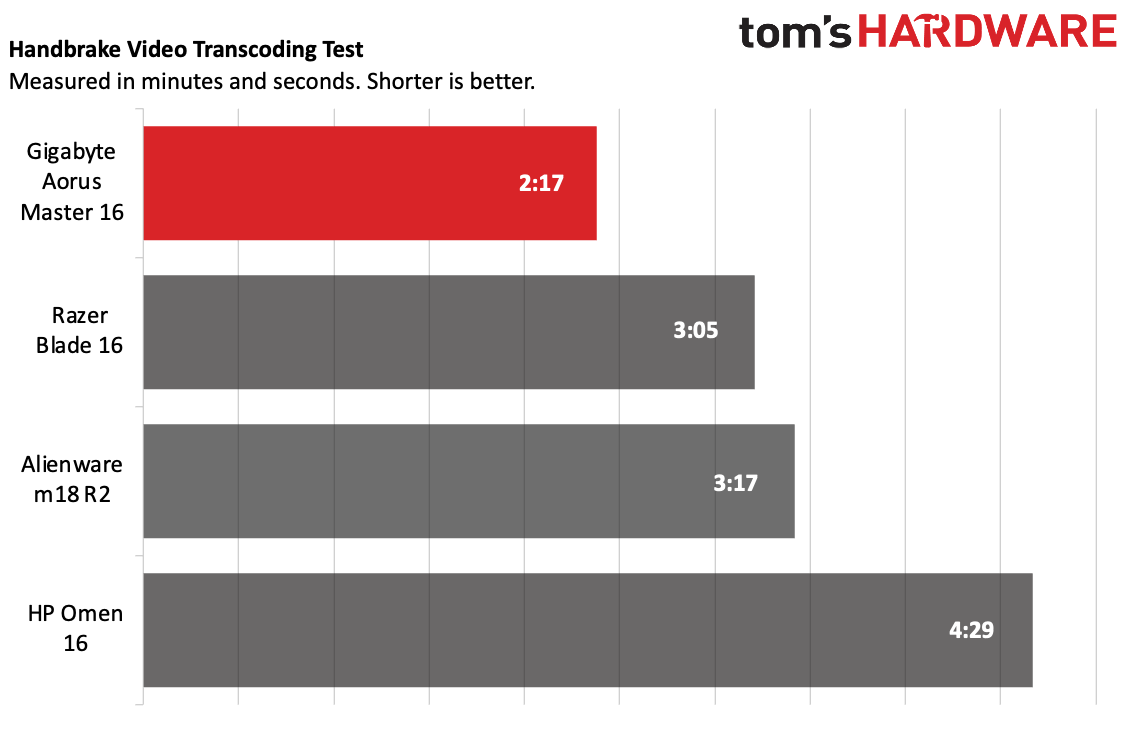
On Geekbench 6, the Aorus Master notched a single-core score of 3,049 and a multi-core score of 19,175. This beat the older Intel processors in the Alienware M18 R2 and HP Omen 16, as well as the AMD Ryzen AI 9 HX 370 in the Razer Blade 16 (which has half as many cores).
The Gigabyte's drive proved slow on our file transfer test, copying 25GB of files at 665.26 MBps. Everything else far exceeded it, with the Alienware m18 R2 taking the lead at 2,304.52 MBps.
But the Aorus Master took the lead on Handbrake, transcoding a 4K video to 1080p in 2 minutes and 7 seconds. The Blade 16 came in second at 3:05.
Display on the Gigabyte Aorus Master 16
The 16-inch, 240 Hz, OLED panel on the Aorus Master is luminous, but not as vivid as Gigabyte's competition.
As I explored a forest at sunrise in Alan Wake 2, the green foliage was vibrant, and the entire scene was lightly colored by an appropriate orange tint.
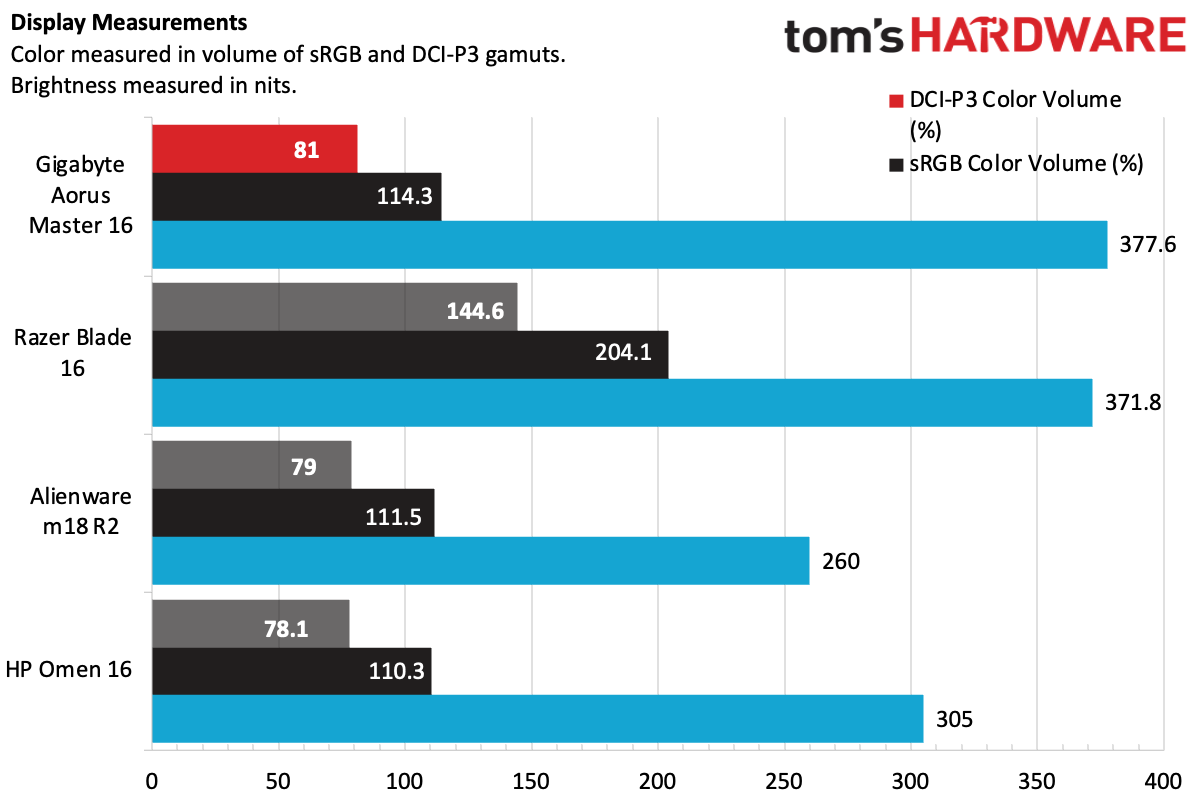
The Aorus has the brightest screen of our comparison bunch at 377.6 nits on our light meter, just surpassing the Razer Blade 16 at 371.8 nits.
But the Razer Blade has the best screen based on color volume. The Aorus covered 81% of the DCI-P3 color space and 114.3% of the sRGB color space, but the Razer beat it by far at 144.6% DCI-P3. In this case, the Aorus was more in line with the HP Omen 16 and Alienware m18 R2, beating them each by only a few percentage points.
Keyboard and Touchpad on the Gigabyte Aorus Master 16
Gigabyte's keyboard features poppy scissor switches that provide a comfortable bounce while writing and gaming. But I wish the keycaps were larger, and there's clearly room for them, as Gigabyte has some speaker grille patterns (but not actual speaker grilles) on each side of the keyboard.
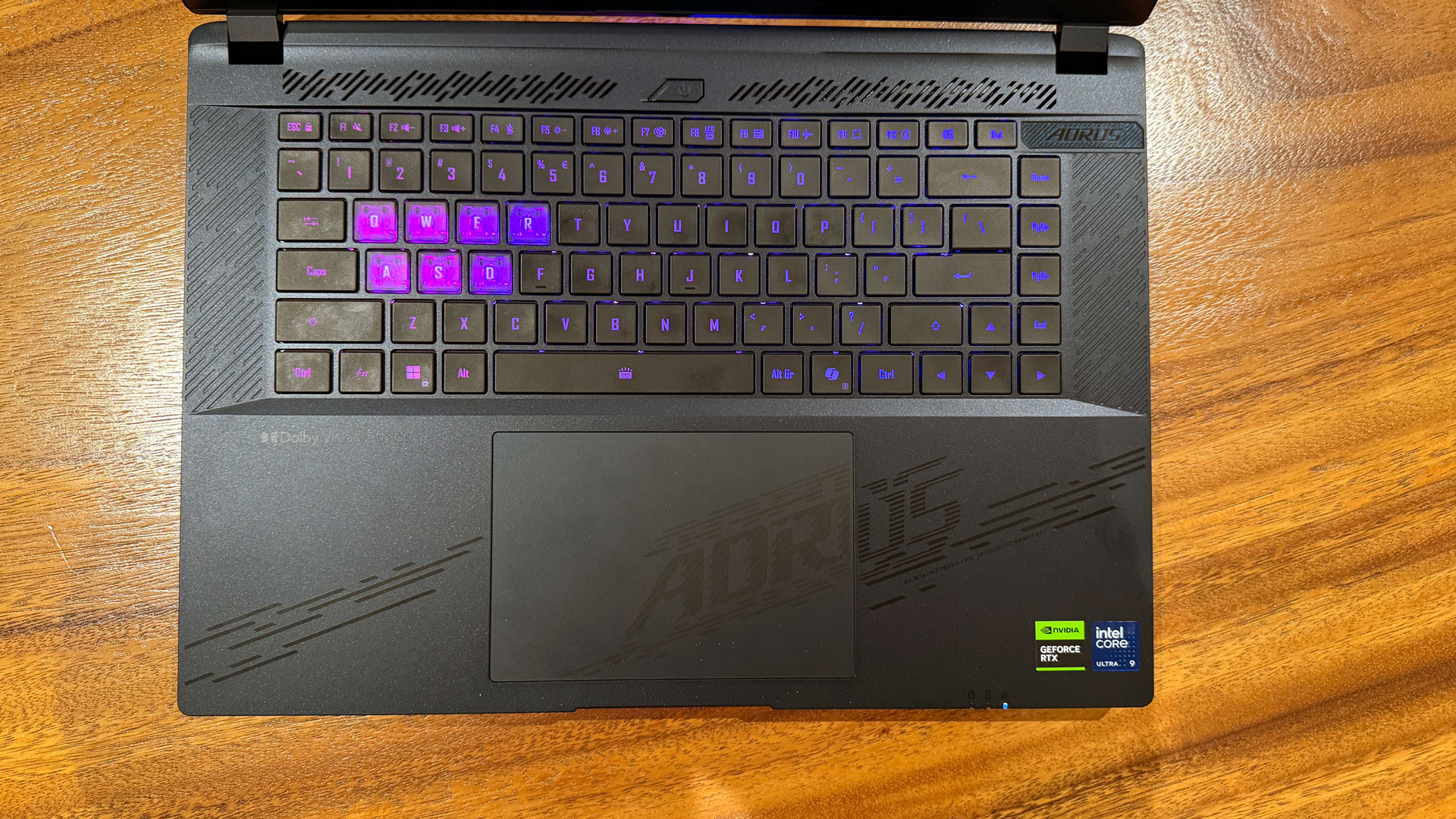
The touchpad is a generous 5.2 inches wide by 3.5 inches tall. At this price, I'd prefer to see haptic feedback, although the mechanical click works well enough here. The touchpad is smooth and worked well with Windows gestures when I used the system.
Audio on the Gigabyte Aorus Master 16
The Gigabyte Aorus Master 16's speakers are passable for listening to music. Doechii's "Anxiety" features multiple layers of vocals on top of a sample of Gotye's "Somebody That I Used to Know," and they were all discernible. While there's not much bass, the xylophone from the sample was loud and clear.
The speakers are better tuned for gaming. In Alan Wake 2, dialogue was clear, and ominous background music was appropriately haunting.
Dolby Access comes preinstalled to adjust the speakers, but making adjustments didn't do much to enhance the experience.
Upgradeability of the Gigabyte Aorus Master 16
Removing the Master 16's bottom cover requires dispatching 12 screws. There are three sizes here, so be sure to keep track of which ones go where.
The cover is held on tight, but a well-placed pry tool around the hinges lets you move around and click through the plastic clips. Be careful when removing the bottom, however, as there's a ribbon table attached to to control the RGB lighting. (In an interesting design choice, Gigabyte has loosely adhered that cable to the battery on the inside.)
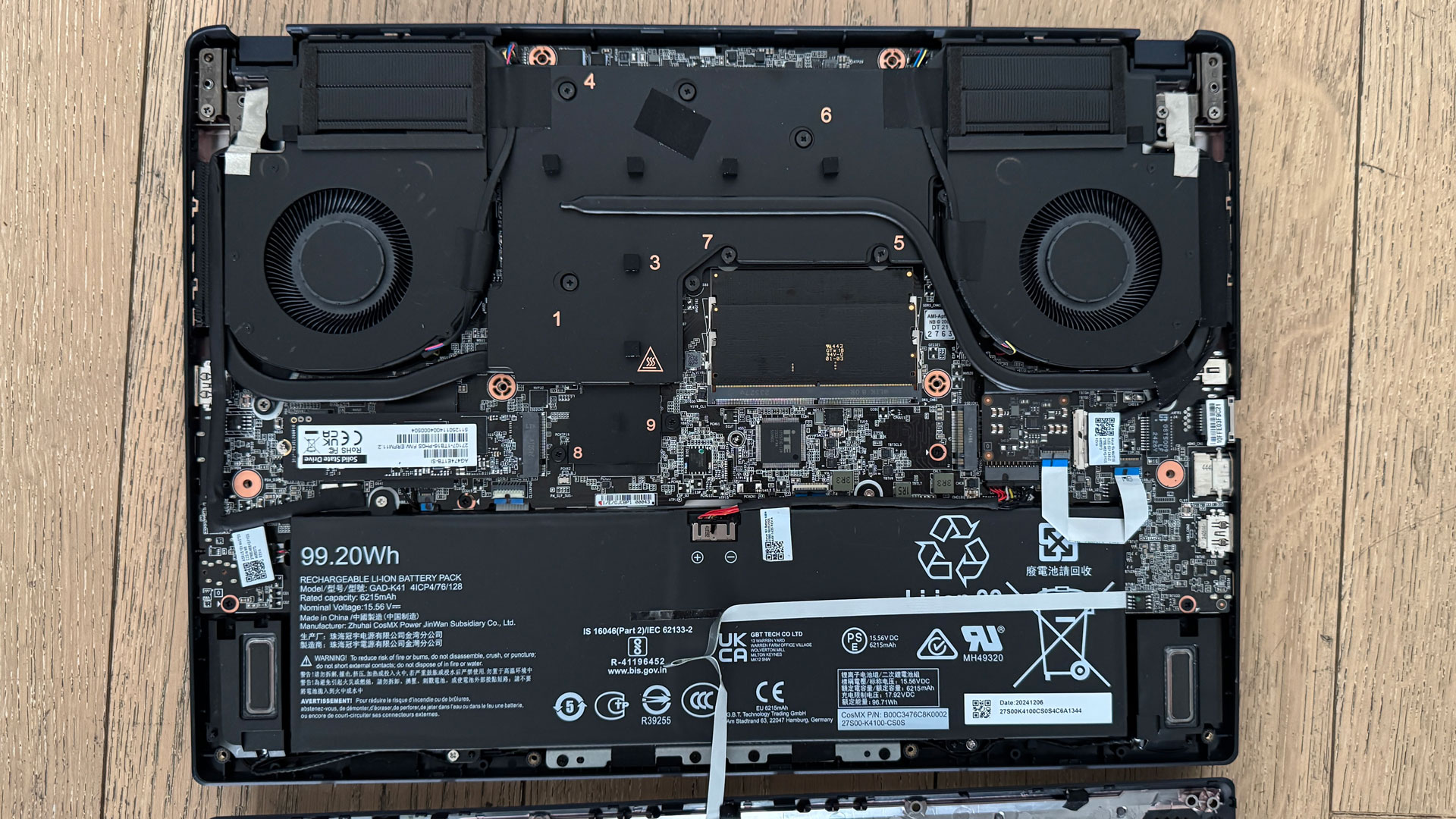
The battery is easily accessible, though you'll need to separate that cable. You can also access the RAM SO-DIMMs and SSD. Our review unit used one SSD, but we appreciated a second slot so that you can upgrade the system on your own later. There's no sign of the Wi-Fi chip, which could be soldered or on the other side of the board.
There is a small daughterboard attached to the mainboard by another ribbon cable. It has a PMIC label on it, suggesting that, among other uses, it could be for power management.
Battery Life on the Gigabyte Aorus Master 16
Gaming laptops usually need to be plugged in to hit their full potential, but the Aorus Master 16 is seeing slight generational gains in battery life. On our test, which sets the screen to 150 nits, browses the web, streams videos, and runs basic OpenGL tests, the Aorus ran for 5 hours and 2 minutes.
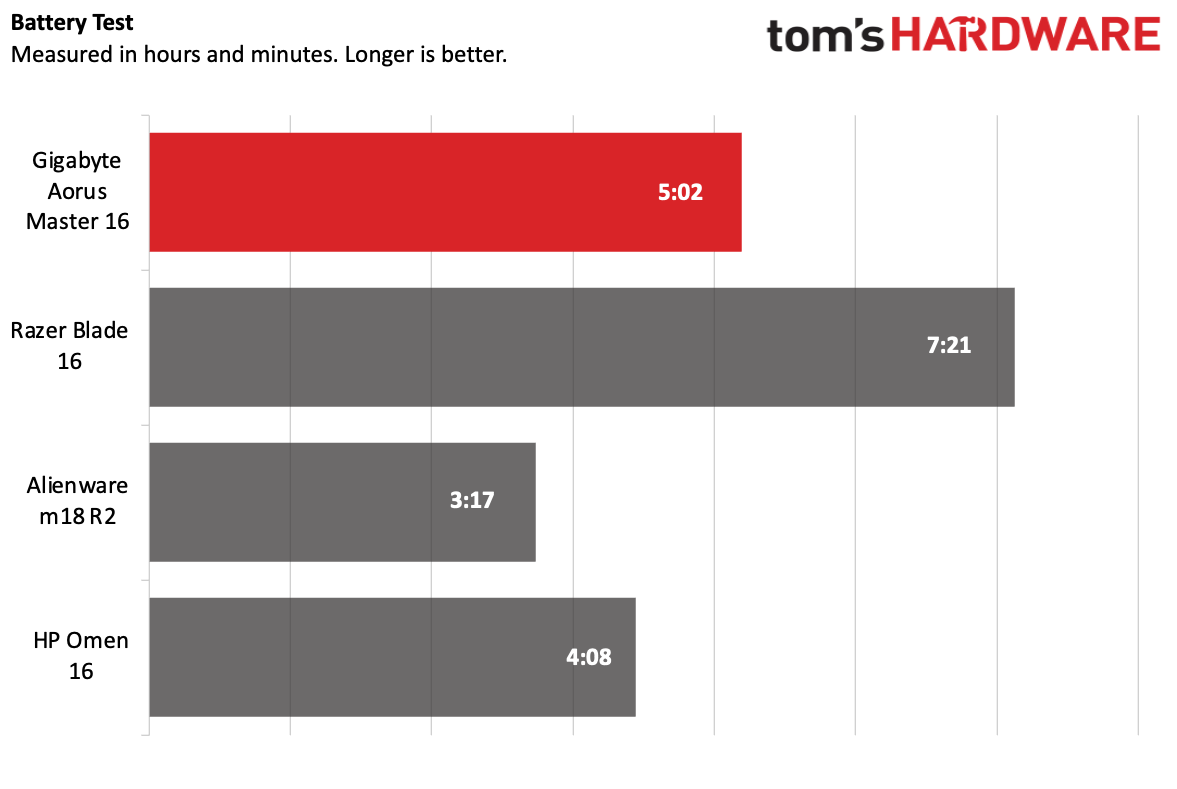
That's longer than last-gen Intel/Nvidia laptops, though the AMD/Nvidia-based Blade 16 - with its 28W CPU - ran for an impressive (at least, for a gaming laptop) 7:21.
Heat on the Gigabyte Aorus Master 16
We measure skin temperatures for gaming laptops while running the Metro Exodus benchmark. During that test, the center of the keyboard reached 92 degrees Fahrenheit, and the touchpad, while largely cooler, had one hot spot at 82 degrees. (That's not too uncomfortable to use, just warmer than the rest of the surface, which was closer to 75 degrees.
The hottest point on the bottom of the laptop reached 108 degrees F, which isn't too bad for a gaming machine of this caliber. Perhaps that’s an argument in favor of the plastic Gigabyte uses for its chassis.
Webcam on the Gigabyte Aorus Master 16
The camera on the Aorus Master 16 just passes muster. It's only 1080p, which is a shame on a laptop for over $3,000, but calls and photos weren't blurry or grainy. Some colors were a bit cool for my liking, and I appeared pretty pale under our office's fluorescent lights.
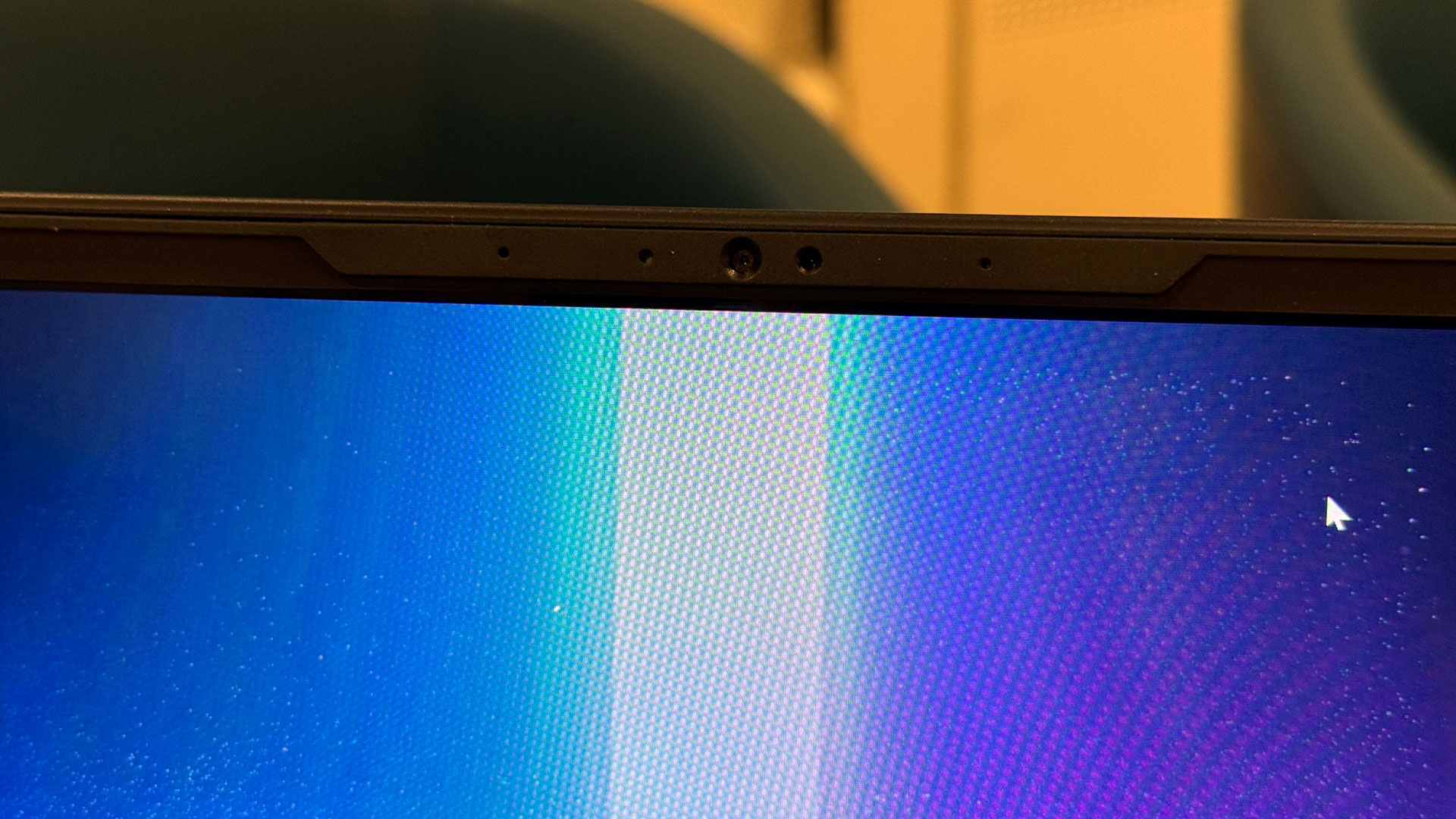
I wouldn't use this camera for game streaming, but it works well enough for meetings.
Software and Warranty on the Gigabyte Aorus Master 16
Gigabyte is mercifully light on the amount of software it includes on the Aorus Master. It boils down two apps: Gigabyte Speed and GiMate. Gigabyte Speed tries to prioritize gaming traffic on your network. The other is GiMate, a system monitor that Gigabyte claims has AI capabilities.
GiMate doesn't actually feel that different from Gigabyte's previous Control Center. Its primary use is for changing performance modes, checking CPU and GPU speeds, and adjusting system settings.
The GiMate is also ostensibly an AI agent. Gigabyte's big innovation to the app is adding a chatbot that doesn't do all that much. You can tell it that you want to play a game, and it will switch to Game Mode. Or you can write "I'm going to a meeting" and it will downclock in "Online Meeting Mode." But in the time it would take to chat with the LLM, you could switch these manually with two clicks.
But when I ask it for the best settings for a game, it doesn't tell me. "What are the best settings for Assassin's Creed Shadows" simply throws the system into Game Mode. All this chatbot does is change hardware settings.
Gigabyte sells the Aorus Master 16 with a 1-year warranty.
Gigabyte Aorus Master 16 Configurations
We tested the Gigabyte Aorus Master 16 with an Intel Core Ultra 9 275 HX, Nvidia GeForce RTX 5080 Laptop GPU, 32GB of RAM and a 1TB SSD, which will run you $3,099.99 as of this writing.
There's one other variant of the Master 16 with the same CPU and RAM, but an RTX 5090 Laptop GPU and 2TB of storage. Those upgrades are pricey, though, bumping the cost to $4,299.99.
Bottom Line
The Gigabyte Aorus Master 16 shows that Nvidia's RTX 5080 Laptop GPU is a powerful chip, often within striking distance of the more powerful RTX 5090 Laptop GPU and even more competitive than the 5090 when paired with a 28W CPU in the Razer Blade 16.
But the Aorus Master, despite its $3,099 price as tested, doesn't feel like a premium device. Sure, the display is nice. But the plasticky build, especially on the lid, just doesn't feel like a laptop that costs so much money. Gigabyte needs to spend a bit more on build quality here.
The GiMate AI isn't terribly helpful, especially the chatbot. Sure, I appreciate the nag to switch to integrated graphics whenever I unplug the device, but Nvidia Optimus can do that for me. The Chatbot is so limited in what it can do that I'd rather just go into an options menu and click.
But the fundamental gaming performance is. While the 5090 outperforms the 5080 at higher resolutions, for my money, I think the 5080 is in a good place. I just wish the Aorus Master felt truly masterful in all regards.

Andrew E. Freedman is a senior editor at Tom's Hardware focusing on laptops, desktops and gaming. He also keeps up with the latest news. A lover of all things gaming and tech, his previous work has shown up in Tom's Guide, Laptop Mag, Kotaku, PCMag and Complex, among others. Follow him on Threads @FreedmanAE and BlueSky @andrewfreedman.net. You can send him tips on Signal: andrewfreedman.01
-
kbtoystory This is 100% good summary. Preinstalled 1TB (Kingston NVMe 4.0) in Slot #1, which supports NVMe 5.0, really seems like a budget pick given MSRP. Ours shipped with 2x 16GB DDR-5600 modules fromReply
Really appreciate the option to upgrade drive space and RAM, but the 12x screws require non-standard screwdriver to remove the bottom panel for access. We were also surprised by the ribbon cable for the lighting, running along the battery, which added another complexity with upgrading.
OLED is bright and we think one of the main distinguishing features versus competitors. Others offer 2TB storage, and larger displays, at this price point for RTX 5080M versions. If not on sale at a nearby retailer, this would not have been our first choice. -
syops Microcenter 5080 model $2349.00 using Microcenter credit card. For that price... Great machine! Great screen! Sound is good. Great cooling. WiFi 7 excellent. As a traveler it fits perfect in my travel bag. ~ 10x14 inch. Gigabyte software is buggy, but functional and should improve with time. Even though the machine has a plastic case, it feels solid. Beats the Razor competitor, how? Price and 175 watts to the gpu and 330 watt psu. Razor has a power limit unless using an external cooler. I think dropping a ton of money into machine is a mistake like the Razor or Asus. Go cheaper with what gets the job done at Microcenter for $2349.Reply
